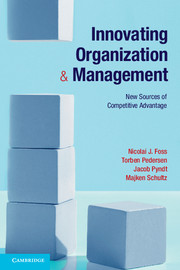Chapter 9 - Concluding reflections
Innovating organization and management to stay competitive
Published online by Cambridge University Press: 05 June 2012
Summary
“It is not the strongest species that survives. Not the most intelligent, it is the one that is most adaptable to change.”
Charles DarwinIn a theory that is today referred to as “survival of the fittest,” Charles Darwin presented his view of competition among different species. A similar theory can be applied to competition among firms. It is not necessarily those firms that are largest or have the most resources that do best, but rather those that are smartest, those that see the new opportunities, and those that develop new ways of doing business. What Darwin called “adaption to change” is similar to what we, in the context of competition among modern firms, denote as “management innovation.” Management innovation is about finding new, smarter, and more efficient ways of organizing activities in firms. Often, changes in the firm’s environment, such as the introduction of new technologies or consumer trends, create opportunities for management innovation. For example, the Internet has paved the way for many management innovations, like e-business and open source communities. In general, the most successful firms will be those that discover and seize new opportunities and then succeed in turning them into management innovations.
While technical innovation is about developing products and production processes, management innovation is defined as “the implementation of new management practices, processes and structures that represent a significant departure from current norms.” Note the elasticity of this definition: “Current norms” may be defined at the level of the firm, the industry, or even the world. In the following, we think of management innovation in an equally pragmatic manner; thus, there is no pretension that what we here call management innovation is necessarily something that is new to the world. The key point is that while technical innovations aim at creating new activities (products or production processes), management innovations aim to organize activities in new ways in order to increase the value that firms can create and appropriate. As outlined in the first two chapters, we think of management innovations as encompassing the following aspects:
new ways of configuring and coordinating the division of labor;
new ways of rewarding employees;
new ways of allocating authority;
new ways of measuring input and output performance;
new standard operating procedures;
new ways of involving stakeholders; and
new methods of global governance.
Basically, a management innovation is a new and better way of organizing, controlling, coordinating, and facilitating existing activities in the firm, explicitly implemented by management to increase value creation and appropriation, and perhaps to a confer competitive advantage on the firm.
- Type
- Chapter
- Information
- Innovating Organization and ManagementNew Sources of Competitive Advantage, pp. 216 - 241Publisher: Cambridge University PressPrint publication year: 2012



